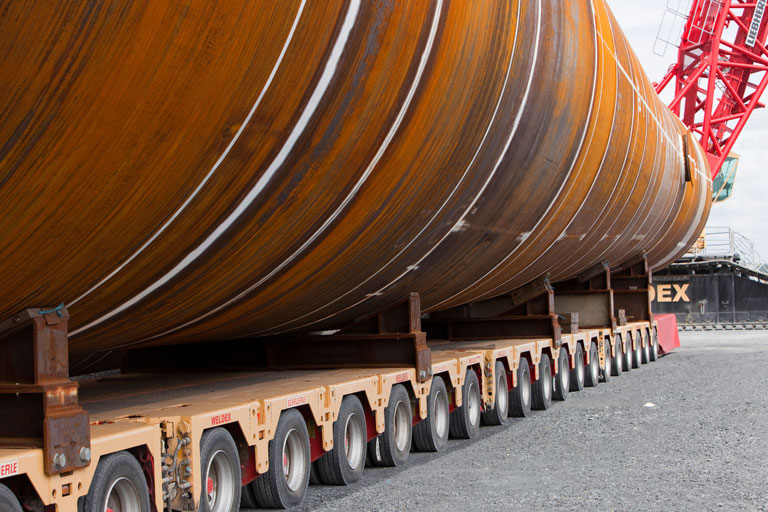Offshore installations, such as wind farms and tidal power stations, are utilising innovative techniques to resist extreme weather conditions and the corrosive, battering force of the sea
While carbon steel is commonly utilised in offshore structures because of its sturdiness, flexibility and cost effectiveness, it is not indestructible. When used in offshore sites, carbon steel is exposed to seawater which can corrode and weaken it over time. In 2016, G2MT Laboratories estimated that the impact of this corrosion caused damages of up to €0.94 trillion in the US alone.
Wind farms and other offshore installations are exposed to extreme weather conditions and lean on the unique qualities of steel to resist the physical pressures presented by high winds and strong wave action. Maintaining the integrity of this steel core is vital to their ongoing operation.
 A wind farm piling waits dockside for loading
A wind farm piling waits dockside for loading
Engineers have worked on several ways to minimise the damaging effect of seawater on carbon steel. One of the most common methods is called cathodic protection. There are two forms of cathodic protection, galvanic and impressed current, which help preserve the state of steel structures in different ways. The first form, galvanic protection, involves connecting another piece of metal to the steel structure as a “sacrificial” metal which corrodes instead of the steel.
“The best analogy would be the school experiment involving copper and zinc in a bath of salty water, wiring them up to make a battery,” says Chris Wozencroft, principal engineer at Corrosion Engineering Solutions. “The zinc is thermodynamically more unstable than the copper. The zinc becomes the anode and will preferentially corrode and the copper becomes the cathode and is protected, hence the term ‘cathodic protection’.”
By manipulating the electrochemistry of the metals involved, and channelling the corrosion into another metal, cathodic protection methods ensure the steel remains unharmed
This can be directly applied to steel structures. A piece of metal more unstable than steel, such as zinc is connected to the structure, making the less stable metal the anode, and the steel the cathode. As a result, the piece of metal corrodes, while the steel structure remains intact. This is galvanic or sacrificial cathodic protection.
A downside of this “sacrificial” approach is that the piece of metal needs replacing as it corrodes away, which can be inconvenient for critical infrastructure or difficult to access structures. In these situations, impressed current protection is the more suitable solution.
“Instead of using a piece of metal which is thermodynamically unstable, we use metal which is totally inert,” Wozencroft explains. “Just connecting it to the steel structure is going to do nothing because it’s inert. But if you connect a DC power supply to it and apply an activator coating, you can make it behave like an anode by manipulating the electron flow.”
While the metal doesn’t need to be replaced, the DC supply that is required can be large. This makes it more expensive to maintain, so using impressed current protection is a trade-off. Galvanic protection is simple, but needs regular replacement. Impressed current lasts much longer, but has its own considerations, such as increased costs.
Both methods provide effective protection for offshore carbon steel structures. By manipulating the electrochemistry of the metals involved, and channelling the corrosion into another metal, cathodic protection methods ensure the steel remains unharmed. Stronger steel makes for stronger structures, so tidal installations and wind farms can continue producing clean energy long into the future.
Images: Alamy